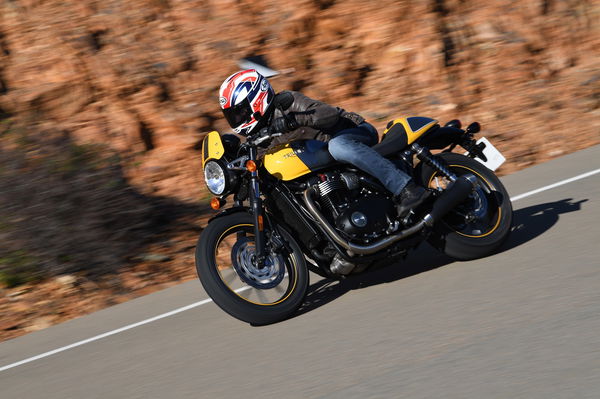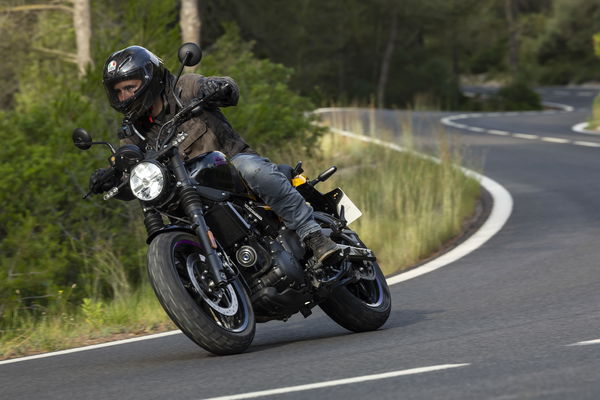Street Scrambler review
The Triumph Street Scrambler is here, and it's bags of fun to take for a ride.
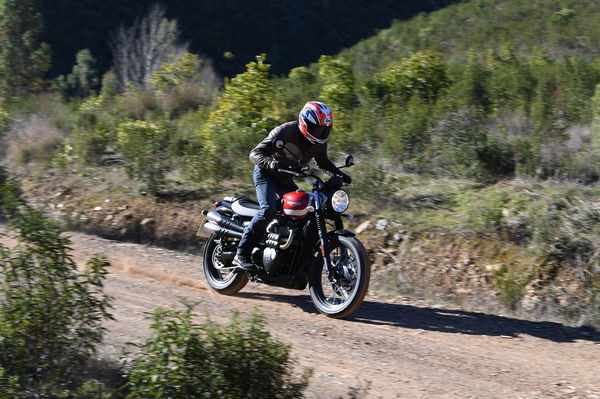
The Triumph Street Scrambler twins the kind of charm you get from the Bonneville range with a fun ride that we can't get enough of.
Triumph Street Scrambler: Design
The heritage that feeds in to Triumph’s latest Scrambler can be traced back to the 650cc Bonneville T-120TT of the early '60s. But the Scrambler as we know it was launched in 2006 and apart from the addition of fuel injection and a few detailing tweaks, it’s remained largely the same since then.
But now we’ve got a new Scrambler - the Street Scrambler, launched alongside the new Street Cup. It uses the new 900cc water-cooled parallel-twin engine from the Street Twin, has a high-level exhaust, wire-spoked wheels, bench seat clad in dual purpose tyres, plus bear trap foot pegs and a bash plate, mate.
Costing £8,900, its price hits a similar mark to competition from Ducati and BMW. It slightly more (£368) more expensive than the Ducati Scrambler Classic, but cheaper than the more rugged forthcoming Desert Sled, which starts from £9,395 and the BMW R nineT Scrambler, which starts from £10,550.
But what does it ride like? Like the most fun loving and playful of the new Triumph Bonnevilles.
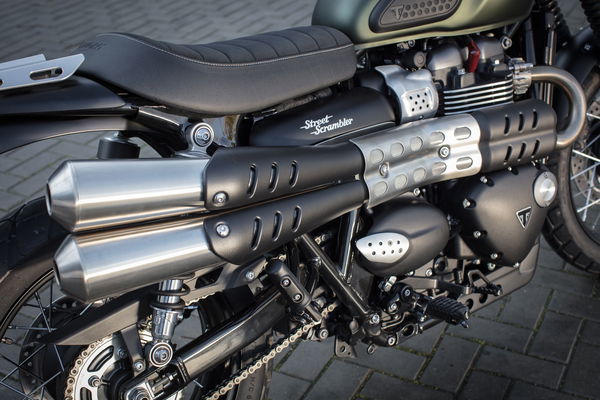
Triumph Street Scrambler: Engine
It’s the result of a combination of things, starting with the engine. The 900cc twin-cylinder motor (housed in the same frame as the Twin and Cup, but with different mounting points) provides plenty of grunt, fuels smoothly and the ride-by-wire throttle delivers a faultless response. It makes 55hp and 59lb/ft torque - the same as in the Street Cup but the engine has a slightly different tune, so peak torque arrives at 2,850rpm and in this bike, my criticisms of this same engine in the Street Cup are less applicable because the Street Scrambler doesn’t egg you on (geddit?) in quite the same way the café racer-style Street Cup does. The 900cc engine also means that this Street Scrambler makes 28% more torque and power than the previous model.
Like the Street Cup it’s heavy – 213kg dry, but it never felt too weighty because it’s well balanced at all speeds. The BMW R nineT Scrambler is quoted as weighing 220kg fully fuelled and ready to ride, while the Ducati Scrambler Classic is quoted as weighing 192.5kg rideable with 90% full tank and the Desert Sled 207kg.
Compared to the Ducatis, the Triumph is down 20hp, although has 9lb/ft more torque. The BMW makes double the horsepower of the Trumpet and with 85.5lb/ft to its name, more torque too.
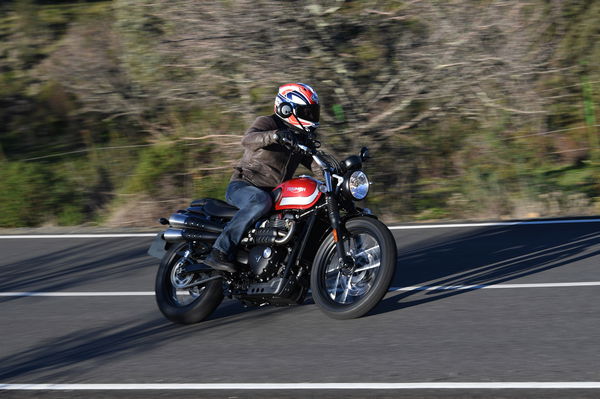
Triumph Street Scrambler: Suspension and Handling
The riding position and ergonomics feed in to the Street Scrambler’s more relaxed approach to things, with the wide bars offering plenty of leverage and control. The 792mm-high bench seat was comfy during the 100 miles or so I spent perched on it and so was the relaxed riding position, which allows all controls to fall naturally to hands and feet.
It’s a bike that delivers exactly what I want in a low speed urban environment – manageability, balance and manoeuvrability. There’s also enough poke to get past everything in the never-ending search for the best flat white, moustache wax, craft beer and books of clichés, which is what I spend all my money on. That and pies.
Away from the hustle and bustle of a town/city, the engine also does well and will whip you down the motorway without complaint, although the lack of wind protection gets hard to ignore after a while.
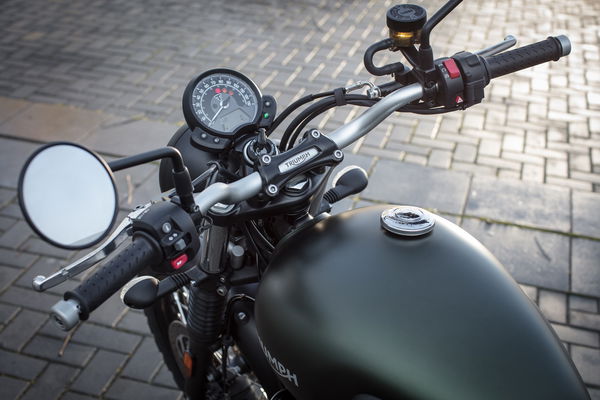
As with the rest of the Street fleet, the Scrambler features switchable traction control, a torque assist clutch, a smart looking and bright LED rear light, trip computer, fuel consumption information and a USB port under the seat. If you’re feeling brave, talented or stupid, you can also turn the ABS off to make skids/crashing that bit easier. The single-big face clock is clear, as is the great paint finish, tidy looking engine and minimal-but-classy overall look of the bike.
The motor is complimented by a lovely pair of high-level exhaust pipes. The headers curl round the front of the engine before going into a side-mounted cat, with the silencers sitting underneath the interchangeable pillion seat and rear rack. As with the Street Cup, the silencers sound sweet, with a similarly fulsome note and a bit of added popping on the overrun. The heatshield did a good job of protecting the inside of my right leg against the warmth of the exhaust.
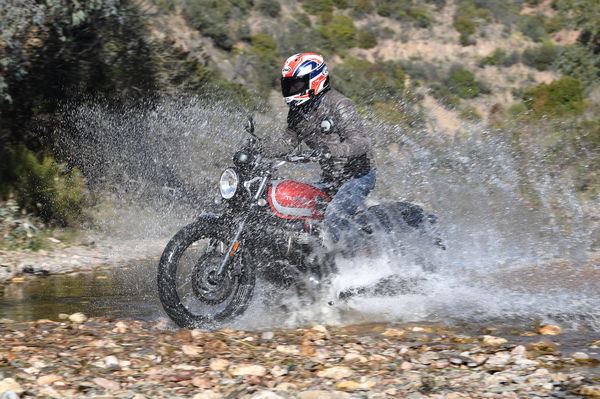
Being a scrambler, it only seemed right that we did some scramblin’ on the test. It was one of the lighter and less painful off-road sojourns I’ve had and to its credit, the Street Scrambler did well. The dual purpose Metzeler Tourance tyres, which roll on wire spoked wheels (19” front and 17” rear) can take some credit for this, as can the wide bars, plus the stable footing afforded by the bear trap pegs. But let’s not kid ourselves here – the most challenging terrain most Street Scramblers are likely to have to deal with is riding over the gravel and detritus that tends to gather in the hatched areas used to separate urban carriageways. Still, it’s nice to know that if you wanted to take your Street Scrambler onto a beach or down a gentle byway, it’s not off the cards. I wouldn’t take it enduro riding though as I doubt the plastic bash plate, as nice as it looks, would take much of a bashing.
One of the key differences between the Scrambler and the Cup is the suspension. The Scrambler gets model-specific components – for improved ground clearance the forks are longer and the KYB twin rear shocks, adjustable for preload, deliver the same 120mm travel that you get at the front.
On the road, the ride is comfortable and controlled. While it didn’t embarrass itself off-road, crossing a few drainage channels quickly exposed the limits of the suspension, which is soft when really tested but well suited to the bike once the tarmac reappears.
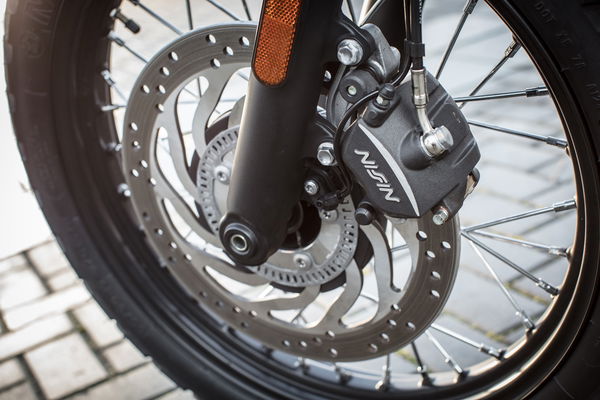
The braking setup is identical to the Street Cup’s, with a two-piston Nissin sliding caliper and 310mm disc at the front, and a two-piston Nissin caliper and 255mm disc at the rear. Braking performance is the same – it’s OK, but the same front-end power deficit and lacklustre feel remain.
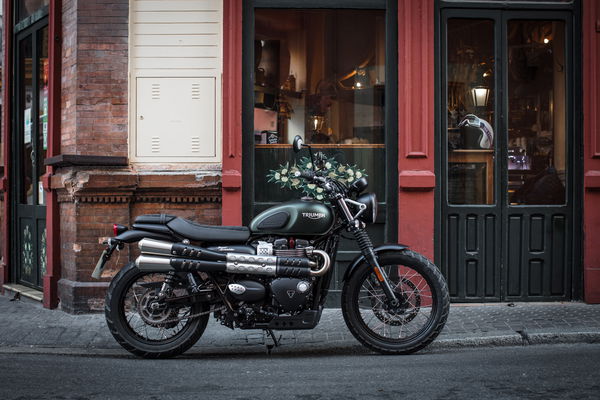
Handling was similarly balanced and neutral and the Street Scrambler steers with confidence. I rode it after the Street Cup and if I’m being honest, I was expecting to be a bored and frustrated with it on the winding roads lurking just outside of Seville. How wrong I was – it just handles in such a neutral, predictable and confident way that I couldn’t help but enjoy chucking it about and the only frustration came at the end of the day when I had to hand the key back.
Should I buy the Triumph Street Scrambler?
The new Street Scrambler is the most fun and playful addition to the Street Twin range, and in my experience, the Bonneville family (I’ve not ridden the Bonneville T120 yet). It’s an easy going, capable and fun bike that definitely looks the part. Its friendly character makes it an accessible prospect for lots of riders and as a smart looking urban ally, I think it’ll be hard to beat. Its real test will come when it’s pitted against more powerful and lighter competition, although this bike has something which the BMW and (to a lesser extent) the Ducatis don’t – heritage, and that’s what this is all about, right?
- Model tested: Triumph Street Scrambler
- Price: £8,900
- Engine: 900cc liquid-cooled eight-valve SOHC parallel-twin
- Power: 55hp at 6,000rpm
- Torque: 59lb/ft at 2,850rpm
- Suspension: Front – Non-adjustable KYB fork / Rear – Preload adjustable KYB twin shocks
- Brakes: Front – Two-piston Nissin floating caliper and 310 mm floating disc / rear – Nissin two-piston floating caliper and 255mm disc
- Wheels: Wire-spoked – 19” front, 17” rear
- Tyres: Metzeler Tourance – 100/90/19 front, 150/70 R17 rear
- Weight: 213kg dry
- Fuel tank capacity: 12 litre
- Seat height: 792mm
- Colours: ‘Jet Black’, ‘Matte Khaki Green’ and ‘Korosi Red and Frozen Silver with Jet Black hand-painted coach lining’
- Availability: In dealers now
Photos: Alessio Barbanti and Matteo Cavadini
